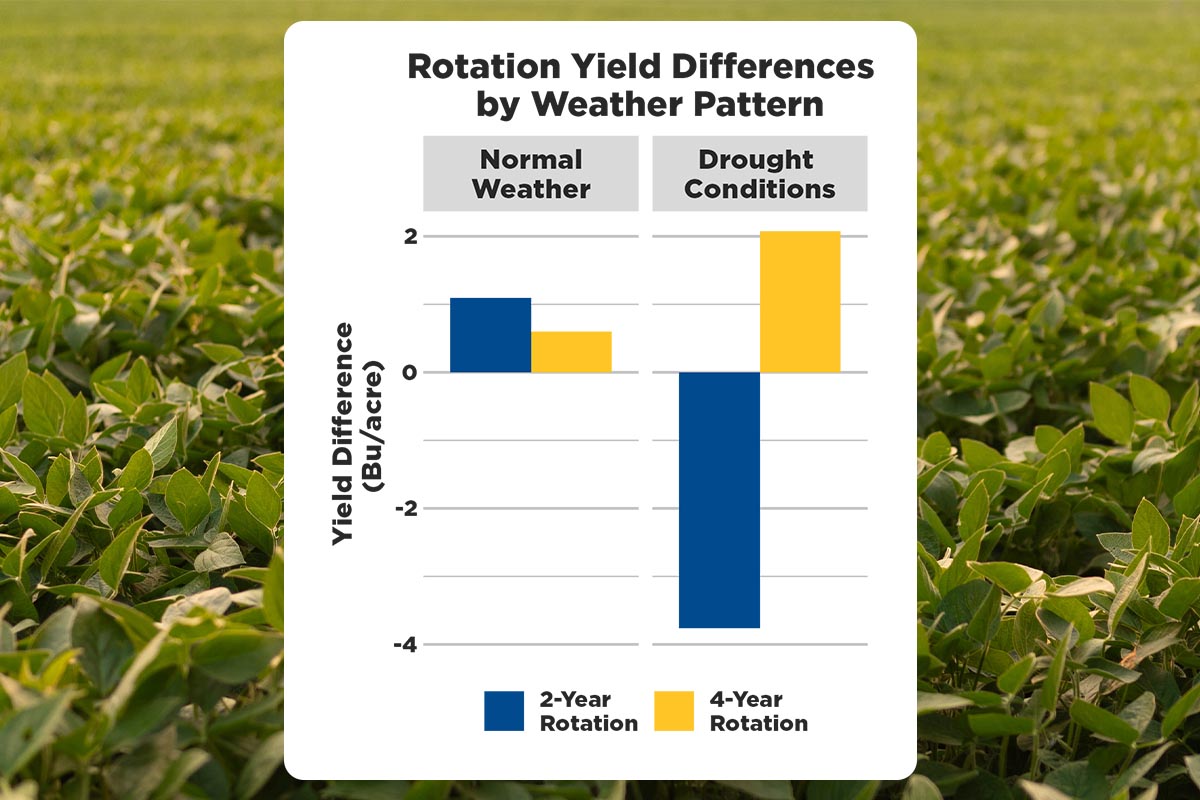
(Photo: Iowa Soybean Association)
Soil management boosts drought resilience
June 30, 2025 | Matthew Carroll, PhD
Key Insights
- Iowa's shifting weather brings more spring rain, summer droughts.
- Four-year crop rotations boost yields and resilience in drought conditions.
- Other practices can also decrease compaction and improve water infiltration.
Iowa weather patterns are predicted to change with spring rainfall likely increasing and longer periods of drought in the summer, according to the National Oceanic and Atmospheric Administration.
Since May 2020, much of Iowa has been under drought conditions. During the 2023 cropping season, an average of 90% of Iowa was under a drought.
Iowa Soybean Association (ISA) is supporting research at Iowa State University (ISU) evaluating how diverse cropping rotations affect soybean growth and development under current and future weather patterns. Most Iowa farmers don't have the ability to irrigate, but there are management methods that can improve resiliency during drought conditions by improving soil features such as water holding capacity and infiltration rates.
A team of agronomists, led by ISU Agronomy Associate Professor Marshall McDaniel and Postdoc Research Associate Ashani Thilakarathne, are testing current and future weather patterns under a two-year soybean and corn rotation, and a four-year rotation that includes corn, soybeans, oats and alfalfa.
Since 2002, the Marsden Agricultural Diversification Experiment (MADE) has evaluated outcomes in farm profitability, yields and soil health under various management controls. In the diversified system, composted cattle manure supplied most of the crop fertility needs. Synthetic fertilizers supplemented the remainder of crop nutrient needs based on soil tests and ISU recommendations.
In the two-year system, all inputs were from synthetic fertilizers based on results from soil fertility tests and ISU recommendations.
Previous work at MADE showed an increase of 1400% in water infiltration rates, a 16% increase in soil water storage and an 8% reduction in resistance to root growth (compaction) in the diverse rotation compared to the standard two-year rotation.
Expanding the research
McDaniel and Thilakarathne wanted to test if these improvements in soil health under a four-year rotation would lead to greater crop yields under drought stress compared to the business-as-usual two-year rotation.
Researchers controlled changes in rainfall for each plot using Precipitation Exclusion and Application Systems (PEAS), shown in the image below. These structures allow the researchers to take a small portion of each plot and control the amount of water each treatment receives. By restricting rainfall on each plot, soybeans can be tested in a field environment with modified rainfall to simulate current and future drought conditions and changes in soybean growth and development in each of these rotation systems.

The research was conducted in 2023 at the ISU research farm near Boone, and the treatments that simulated current weather conditions received 7.25 more inches of rainfall than the drought conditions, which are expected to be more frequent in the coming year.
The figure below shows that soybean yields differed minimally under current weather conditions; the two-year and four-year rotations yielded 1.1 bushels and 0.6 bushels per acre more than the trial average, respectively. The two-year rotation yielded 0.5 bushels per acre greater than the four-year rotation when adequate rainfall was received by both rotations.

When soybeans were tested in drought conditions, the two-year rotation yielded 3.8 bushels per acre less than the trial average and the four-year rotation had a 2.1 bushel-per-acre-yield increase compared to the trial average.
In drought conditions the four-year rotation resulted in a 5.9 bushel per acre yield increase compared to the two-year rotation.
These results support the original hypothesis that improved soil health under an extended rotation will increase soybean yield resilience in drought conditions, compared to a standard shorter rotation.
This work is a great example of how checkoff dollars are being utilized to look at future scenarios impacting soybean management decisions. As this work evolves, additional research will inform how cover crops impact similar aspects of soil health that can lead to enhanced soybean resilience to challenging climactic conditions.
Work from ISA's long-term cover crop experiments showed a similar reduction in soil compaction to soil that was treated with cover crops from six to eight years, with an average reduction of 6% in the first two feet of the soil horizon.
As farmers look to minimize the risk of soybean yield losses under future drought conditions, it's important to think about what practices can be implemented that help the soil increase water infiltration and water holding capacity.
Reach out to mcarroll@iasoybeans.com via email to learn more about this research or practices to implement on your farm.
Written by Matt Carroll.
Back